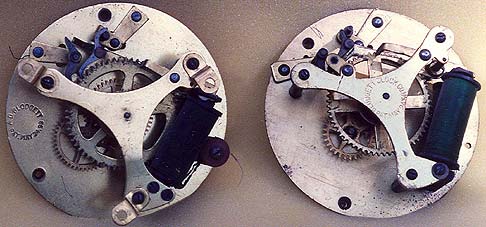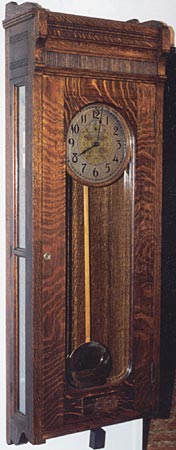
Blodgett Bros. & Co. (later, Blodgett Clock Co.) was established by Aaron D. Blodgett, general manager of the Electric-Industrial Co. of 63 Kilby St., Boston, and George W. Blodgett, chief electrician for the Boston and Albany Railroad.
Blodgett was a small company in Boston that bought many of its parts from Standard and was eventually bought and phased out by Standard. Its products are of great interest to the Standard Electric Time collector.
Evidence is practically conclusive that the very first Blodgett master clocks contained minute-wind movements purchased from The Standard Electric Time Co.
James O. Lyman, inventor of the paper disc (1897) and paper ribbon (1901) program machines manufactured by Standard Electric Time, was granted a United States patent (No. 619,771 dated February 21, 1899) for a Blodgett secondary clock movement made entirely, or nearly so, by The Standard Electric Time Co. Oddly, however, these Standard-built movements bear the same “A. D. BLODGETT PAT. MAY 24, 98” stamp impression found on the commoner Blodgett secondary movements which do NOT appear to have been made by The Standard Electric Time Co.
Much later, on March 1, 1909, Aaron D. Blodgett and Fred S. Atkinson applied for a patent on an hourly-wound master clock movement featuring a long-throw winding lever-- apparently an unsuccessful attempt to improve on the design of the popular and reliable style “F” movement made by the Self Winding Clock Co. The resulting United States patent No. 939,791 was awarded on November 9 of the same year. Several examples of this movement have been located, although total production was probably less than 100 units. It uses Standard Electric Time A-frame plate stampings, with some parts of the winding mechanism strongly resembling those from the SWCC “F” movement. “-MADE BY- BLODGETT CLOCK CO. -BOSTON, U. S. A.-” appears on the front plate just below the seconds arbor. But the absence of any reference to a patent suggests that production was discontinued by or about the time the aforementioned patent was issued. From that point onward, all new Blodgett master clocks were originally equipped with regular production Standard Electric Time master regulator movements, which likewise were often installed to replace troublesome movements in earlier clocks. The very last few Blodgett cases contained everything “Standard” right from the beginning.
J. R. W.
~ ~ ~ ~ ~ ~ ~ ~ ~ ~ ~ ~
Use the link below to access the online gift shop of the American Clock and Watch Museum at Bristol, CT. Click on “Trade Catalog Reproductions” and you will find an early Blodgett catalog with a 4-page history by David N. Rooney added.
American Clock and Watch Museum Store

















~ ~ ~ ~ ~ ~ ~ ~ ~ ~ ~ ~
Jeffrey R. Wood, creator of the Standard Electric Time Co. (SETCO) pages of clockhistory.com, passed away in August of 2018. I will maintain the SETCO web pages in honor of Jeff, but will not be making any additions or changes, or answering any questions. It is hard to express how much I miss Jeff, his friendship, and his wonderful contributions to Standard Electric and Westclox research.
Bill Stoddard